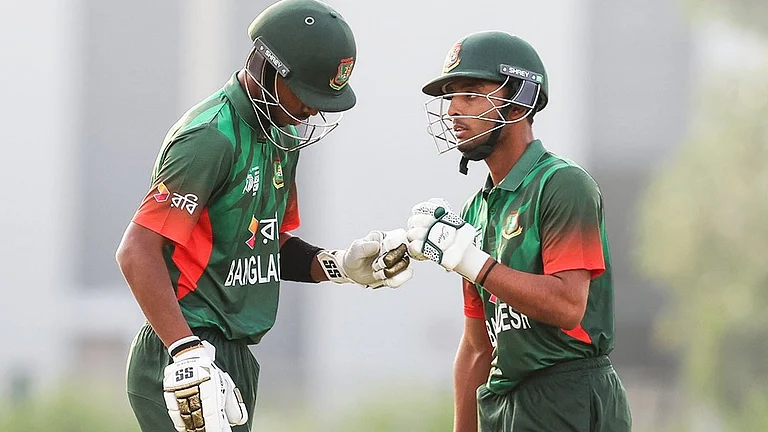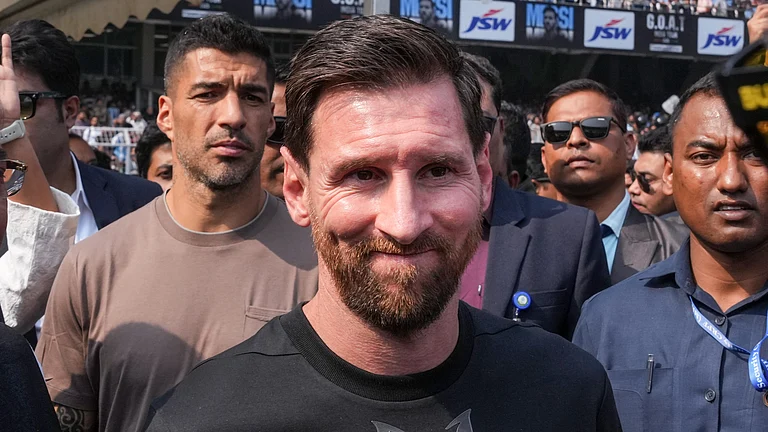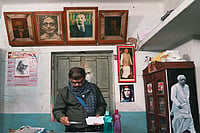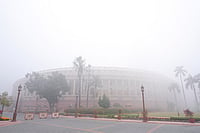Dev van—God's Wood, in the master's language—is one of India's anonymities, a non-place where the cartographer fell off the map. A small fastness of cedar and pine on the crest of a blur of habitation, it passes mutely by as you turn the bend from Garhwal into Himachal, so to speak. Villages, fifty or so, range downhill on its three sides. They have a collective name for themselves, one that glues the three belts in an ethnic envelope, sets them apart in the motley hillscape. But maps, even those minted lately, leave this terrain unmarked. You hear about the Survey of India mapmaker whose recce here turned into a blundering sally amid the deodars—he had to be rescued at night from a crevasse, bones fractured and spirit bruised.
An obscure grouping of kindreds who lived in a corner of the Himalayas with no use for maps, their place in the cosmos secure in their minds.
All it needed was a German Indologist to complete the picture. Claus-Peter Zoller, a footloose scholar from Heidelburg, stumbled upon Bangan in the mid-'80s. Love gradually took the shape of an ethnographic opus. Transcribing its body of myth -- especially an eight-hour, nativised tale of the Pandavas—a sense of Bangani's historical deepness took hold of him. It had more than a touch of Sanskrit, even the old Vedic Sanskrit. His curiosity whetted, Zoller dug in deeper, almost as if he knew what he was looking for.... He struck pay dirt with a slender vein of lexicon, embedded in old bards' songs, that even the locals found arcane. The analysis, when it came, was provocative: under its superimposed weave of Indianisms, Bangani had a direct kinship with Europe's ancient tongues, Greek et al. In the rarefied world of academia, the muck hit the fan. The thesis stood every migration theory on its head. By the late '90s, it was the bitterest turf war in Indo-European scholarship, rife with refutations and talk of fraud.
Meanwhile, its absence on official language maps endured. Grierson, grand old man of the Linguistic Survey of India, had missed it by a whisker as he rode mule-back through nearby Jaunsar, as the tale goes, in the late 19th century. A century later, in K.S. Singh and Manoharan's Languages and Scripts of India, or in hard-trawling, American bibles like Ethnologue, it still finds no mention. Yet, today, type in 'Bangani' on Google search—in 0.2 secs flat, you land 1,481 matches. Funny destiny for a Garhwali language that no one here has even heard about, and which lives oblivious to its own peculiar infamy. The predicament ties it to hundreds of little argots that secure and embank themselves, holding out against the flux. Pan oblivion and local identity—from the 'Aryan' Dah-Hanu in Kargil to the unclassified Jarawa of the Andamans, the duality stalks India's linguistic landscape.
Whether you see something or not depends partly on the picture's 'degree of enlargement'. An equal factor, doubtless, is: do you want to see it at all? Ever since modern India decreed that linguism be the basis for organising its states, it has fostered an abiding delusion—of big languages owning large territories, carving up the map in clean, unmessy lines, the spoils parcelled out to political sub-entities. There might be irritants—second-rungers clamouring to get into the 'scheduled' list, a few border problems—but overall it's a cheerful picture of qualified homogeneity. The delusion is easily cured, suffice it to open your eyes...and ears. Real Audio, if you like.

Hindi. The word is Persian, today it means an idiom cleansed of Persian contamination. It also gives its name to a vast swathe of land, all but half of India—the alleged Hindi belt. No one would fain imagine this to be an undifferentiated 'isogloss', where everyone speaks clipped, copybook, DD News stuff. There are the dialects, but to deny them a strong family likeness is surely a fallacy? Dissolve this image, for a while. Think of it as India's youngest language, a contingency of recent history. "Not too long ago," says sociolinguist R.S. Gupta, "Hindi was characterised as khari boli, a speech variety, i.e., a dialect. And Braj was a bhasha, a full-fledged language with a long literary history. It's an irony of political history that the equation has now been inverted."
The distinction is conceptually slippery—"a language is a dialect with a gun in its hand", goes the maxim. So leave Braj, Awadhi, Bhojpuri et al with this nugget: news came just this fortnight that in UP's government schools, students flunk Hindi en masse—50 per cent at senior level, 90 per cent at junior. Bad teaching, rest assured, is only half the problem; across this mottled ruralia, what the kids learn as their mother tongue is, for all purposes, a second language. Also leave the welter of hill languages that exist across a gulf of intelligibility. Consider that, on a technical analysis, Punjabi is closer to Hindi than is Marwari, Rajasthan's chief variety (speakers: 12 million). Yet one is recognised as a separate language, the other subsumed. Or that a literate man from Nalanda, Bihar, was "unable to comprehend a word of the Bundeli chatter inside a local train" as it passed through Jhansi. A fate that would doubtless await any Hindi pundit who steps five miles out of Delhi into Haryana, which itself has five varieties, and listens to locals as they talk among each other.
If your radars (rather, sonars) are keen enough, they will pick up sounds, a gently unfolding cacophony, at each succeeding layer beneath the official silence. There are alternative ways to approach this reality. One such was proposed in the '50s by J.J. Gumperz, a short and stubby German-American who authored celebrated studies on caste-based variations in a UP village, and on a linguistic 'triangle' in the Deccan. A few years spent with ears to the ground, and he offered this radical thesis: India is a chain of "village dialects", a continuum from Sindh to Assam of discrete units—each village partly diverging from, partly overlapping with its immediate neighbours. No blocs, no topdown stuff, just a long dotted line. Back in India this summer after a gap of three decades, now an eminence grise of the academe, Gumperz told this writer: "I was reflecting a climate of opinion that existed among Indian linguists like Suniti Kumar Chatterjee. It emphasises diversity. I am open to this being recast." True, for all its liberating qualities, the Gumperz model is an idealisation of a different sort. For, the actual map is fuzzier, replete with interruptions, elisions, jagged edges, sudden irruptions, mutations, absences, disputed territories.
And surprises. An African language survives, split into two, on our west coast, a relic of maritime history—the Siddhis, brought as slaves on Portuguese ships half a millennium ago.

One branch lives in the Gir forest, Gujarat; the other in the north Karnataka woods. A three-lakh-strong silk-weaving community scattered in Tamil Nadu gets along by speaking Saurashtri in the heart of Dravidian country.(The cultural encounter seems to have given a Raga Saurashtram to Carnatic music.) On Minicoy island—a slender, one-street marvel on the extreme south of the Lakshadweep group, where the men are full-timers at the sea and women run the local economy—they speak Mahl, linked via Sinhalese to the northern Indian languages rather than to the Malabarese spoken on the other islands. Or take Brahui, in Baluchistan, discovered about a century ago to be a Dravidian language—a fact that has been rich fodder in the competing claims over the Indus civilisation.
More slices of life. Step out of the office where this piece is being written, into a messy south Delhi market, and find Sikh shopkeepers who talk to each other not in Punjabi but Pashto—their Kabuli background also makes them conversant with Russian, a gift that still guides their economics. Mostly, this seething linguistic undergrowth fails to register on the official consciousness, but sometimes it exhibits a studied sensitivity. All India Radio's Srinagar station—which, as a journalist put it, "is called Radio Kashmir to appease local sentiment"—broadcasts in "seven languages: Kashmiri, Shina, Balti, Pahadi, Gujri, Urdu, Punjabi" (and we still haven't counted Ladakhi, Zanskari, Dogri...).
What are we to make of this melange, this unruly ensemble, this 'buzzing, blooming confusion' that is the real linguistic India? Do we strut about with dialects with guns, silencing it into submission? What indeed does it mean to engage in a language tourism, scooping out exotica for the benefit of 'Indian' ethnological albums? We run the risk of creating a gallery of specimens, a linguistic museum smelling of formaldehyde, unless the talk is leavened in some fashion. Desire, memory, a volitional gesture, some sign of life. Everyone speaks, incessantly pouring words out into the public, yet it's an aspect of being that inheres in us so totally: like the brick and mortar of cognition. We think in it, so to think it we can do no better than to spin metaphors. One is to invest language itself with life, and all that's biological—birth, growth, decay and, yes, death. Languages die. Ahom is dead in Assam. A dozen Andamanese tongues are extinct, more are probably going as you read this.... This prospect evokes two contrasting responses. One is crude social Darwinism: let the brutes survive, and those who'll adapt; damn the rest. The other echoes the conservationist's apocalyptic chants. One makes a virtue of ignorance, the other puts languages on a par with trees and lion-tailed macaques.
The other is to restore it to a political space. A conscious play, manifest or subtle, of dominance, resistance, accommodation, submission. One way speakers deny their own language is in a silent transaction between the periphery and the core of the linguistic state (or bigger sub-national identities). Say, Maithili vs Hindi or Sylheti vs Bengali. The educated elite is perpetually sliding towards the centre, and covering its tracks. They internalise its norms of goodness, notions of what is vulgar and what is refined; provincial ego is inverted into its negative, the identity collapsed with that of the whole. The effect: desuetude, partial eclipse, and with the numerically fragile, possible obsolescence.
Languages also survive. In fact, they exhibit a self-preserving trait, a tenacity, which can be understood only culturally. Indo-Portuguese, a creole, clings on in pockets like Daman. Konkani speakers who fled persecution in colonial Goa 500 years ago are strewn all down the west coast—no script, no institutional backing, yet in innumerable little domestic fiefs they keep the faith, coming back home to the mother tongue from the alien out-there everyday.An archaic Punjabi still lives in a Hyderabad suburb, and a Lahore hotel bellboy speaks Kangri at home, three generations after Partition—the polyglot, a daily refugee in what Gumperz calls "the ethnic separateness of home life", as a fact of the tormented, modern world.
The India that Gumperz saw in the '50s was no placid idyll; in that young nationhood, politics was never too far from the surface. In a few years, Punjabi Hindus would, almost to the last man, record their language as Hindi. Then there was this other, more pernicious fallacy—India's linguistic partition. "I used to ride around on a bicycle in a western UP village, doing my field work. At one house they'd remark, 'How well you speak Hindi!'. Yards away, another family would compliment me, 'You really speak good Urdu'. Both referring to the same thing!" Gumperz recalls. This is a delusion the modern Indian state has worked hard to reinforce, via its textbooks, the media and its proliferating babble.
Soon, the South discovered itself. Ram Jivan was a Hindi teacher in the mid-'60s when news came of the language riots in Tamil Nadu. "I was incredulous. How could anyone hate Hindi?" He was moved enough to go south and find out for himself. Over the years, he mastered Tamil—and taught it to dozens of people, "right up to Shankar Dayal Sharma". He spent the rest of his life working on a multi-language comparative dictionary, but the maverick philologist's orientation stayed. "Modern Tamil vocabulary is 40 per cent Sanskrit-based," he told this writer a few monsoons ago. Chauvinism, one mirroring the other's, has set the tone for what should've been a calmer reflection on a great, long history of contact, cohabitation, assimilation.
Allow for the messy empirical—even the Rig Veda shows traces of dialectal variation; none of the 'Classical' authors were probably native speakers; and Sanskrit too is, naturally, not without Dravidian borrowings. We are left with a named duality that is rich at the representational level: Sans-krit, the Well Created, arching above all else as the unchanging ideal; defined against Prakrit, the Natural, fluid and mysteriously alive. A crucial substratum still eludes this ambit. The Tribal, the word itself a web of stigmata. It gives us this paradox: an average Munda boy, on India's lowest social/literacy echelon, has more linguistic competence than anyone above him. He knows his own language, two neighbouring tribal languages, the lingua franca Sadari, and a fair bit of Magahi, Bhojpuri and bazaar Hindi. (Compare the repertoire of an urban techno-brahmin; one and a half?—and thank Macaulay for it.) Of more fundamental interest is the reading that Munda has lent a climatic context to every other language group, morphing them all into a specific Indian type. Not via lexical conquest, but the unconscious devices and protocols of grammar. The question, 'What is Indian in Language?', may yet lead us down the least heralded path.
The State aspires to be panoptic, but it's petrified of the natural order—it sees in it clutter and anarchy. Difference is disintegrative; the koine is its preferred currency. It's blind to the kind of fragile resolutions that happen on the ground, deaf to its phonic ebb and flow. English is a different curry on each regional palate. Hindi is one thing in Buxar, quite another in Bombay; around Hyderabad, it meets Telugu and becomes Dakkhini. Meitei loses its script to the Vaishnavite conquest, but the encounter produces a new admixture, Bishnupriya.If the northeastern states agree to disagree, they have Nagamese to do it in. In the south, the long trade with Arabia spawns Arwi—it lives 800 years, and dies quietly with its historical context. It's mapped on our brain, this archive of a billion memories. Outside it, there's collective, programmed amnesia.
























